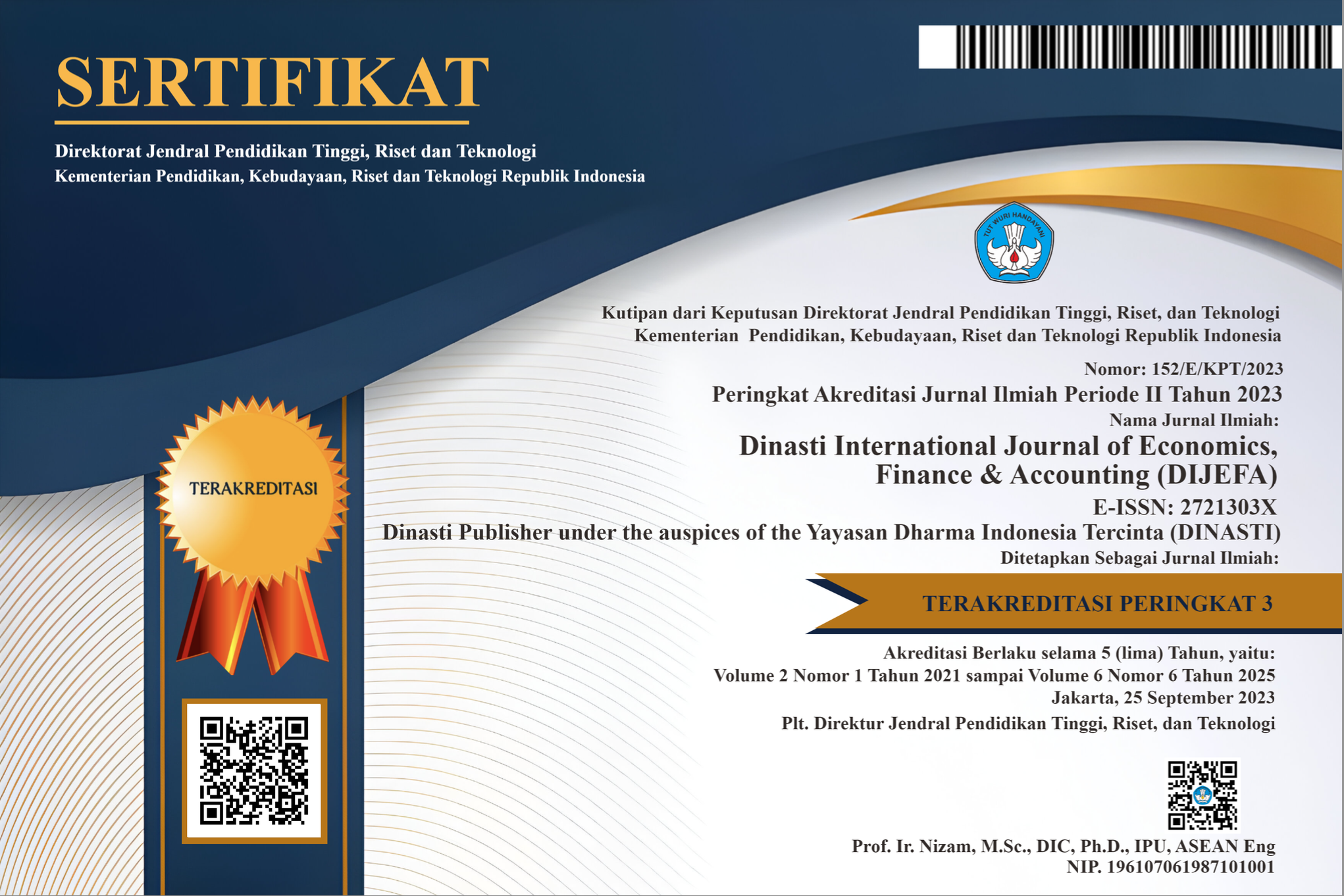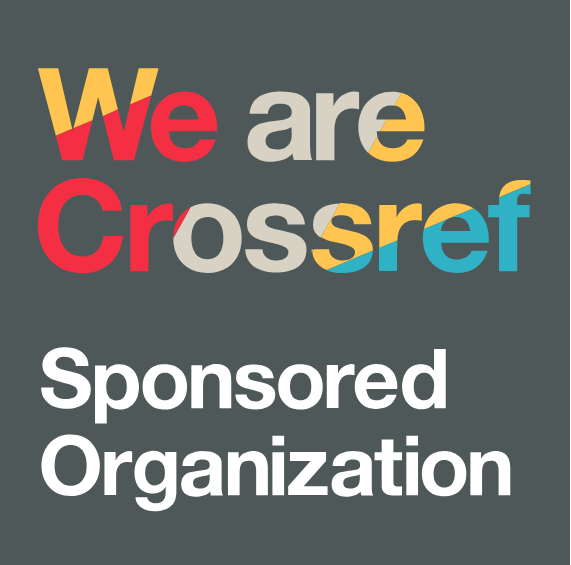The Influence of Organizational Culture, Leadership Member Exchange, and Compensation on Happiness at Work of Millennial and Gen Z Generations at PT Bank Tabungan Negara (Persero) Tbk Regional Loan Processing Center 1
DOI:
https://doi.org/10.38035/dijefa.v6i1.3861Keywords:
Organizational Culture, Leadership Style, Leader-Member Exchange (LMX), Compensation, Happiness At Work, Millennial Employees, Gen Z EmployeesAbstract
The aim of this study is to analyze the relationship between organizational culture, leadership style (Leader-Member Exchange), compensation, and happiness at work among millennial and Gen Z employees at PT Bank Tabungan Negara (Persero) Regional Loan Processing Center 1, West Java. This study employs a quantitative research design to analyze the relationships between organizational culture, leadership style (Leader-Member Exchange), compensation, and happiness at work among millennial and Gen Z employees at PT Bank Tabungan Negara (Persero) Regional Loan Processing Center 1, West Java. The data collection methods include internet-based surveys and a literature review. The study sample consists of 131 permanent employees, with a saturated sampling technique. The data were analyzed using descriptive statistics and Structural Equation Modeling (SEM) based on Partial Least Squares (PLS-SEM) to test the relationships between variables.Based on the analysis results, this study concludes that organizational culture, compensation, and Leader-Member Exchange (LMX) significantly influence happiness at work among millennial and Gen Z employees at PT Bank Tabungan Negara (Persero) Regional Loan Processing Center 1. Increases in organizational culture, compensation, and LMX are positively related to happiness at work. LMX also serves as an intervening variable that strengthens the impact of organizational culture and compensation on happiness. LMX is the highest indicator with the most significant influence on happiness at work, while organizational culture has the lowest influence.
References
Aji, G., Abidah, N., & Zakiyya, H. R. (2023). Representasi Gaya Hidup Halal Dalam Media Sosial Di Kalangan Generasi Milenial. Musytari?: Jurnal Manajemen, Akuntansi, Dan Ekonomi, 2(5), Article 5. https://doi.org/10.8734/musytari.v2i5.1162
Ayu Asrianingsi, Akhmad, A., & Nasrullah, N. (2024). The Effect of Workload on Employee Performance at PT. Suracojaya Abadimotor Daya Branch, Makassar City. International Journal of Economic Research and Financial Accounting (IJERFA), 2(4). https://doi.org/10.55227/ijerfa.v2i4.146
Bakanauskiene, I., Bendaraviciene, R., & Daugintaite, I. (2019). Workplace happiness: Evidence from Lithuania. Rozwój Potencja?u Ludzkiego, 35.
Bani-Melhem, S., Al-Hawari, M. A., & Quratulain, S. (2022). Leader-member exchange and frontline employees’ innovative behaviors: The roles of employee happiness and service climate. International Journal of Productivity and Performance Management, 71(2), 540–557. https://doi.org/10.1108/IJPPM-03-2020-0092
Bestari, D., & Prasetyo, A. R. (2019). Hubungan Antara Happiness At Work Dengan Organizational Citizenship Behavior Pada Karyawan Pt. Telkom Witel Semarang. Jurnal EMPATI, 8(1), 33–39. https://doi.org/10.14710/empati.2019.23571
Buzza, J. S. (2017). Are you living to work or working to live? What millennials want in the workplace. Journal of Human Resources Management and Labor Studies, 5(2), 15–20.
Coopers, P. W. (2011). Millennials at work: Reshaping the workplace. Pricewaterhouse Coopers International Limited (PwCIL), 1–28.
Cornelius, A., & Macaluso, P. (2003). The Berry Informational Technology (B.I.T.S.) Student Work Program: An Effective Environment for Collaborative Learning, Leadership, Technological Training, and Certification. For full text: http://www. https://eric.ed.gov/?id=ED479243
Deloitte, S. L. (2022). Deloitte. Deloitte. http://www.insolvencies.deloitte.ca/Documents/ca_steelback_NoticetoCreditorsSteelback_oct708.pdf
Dyahjatmayanti, D., & Nuggroho, S. P. (2022). Pengaruh Jaminan Kesehatan Kerja Terhadap Motivasi Kerja Karyawan Bandar Udara Di Masa Pandemi Covid-19. Jurnal Manajemen Dirgantara, 15(2), 206–214. https://doi.org/10.56521/manajemen-dirgantara.v15i2.755
Ermawati, Bastian, A., & Wardi, J. (2022). Pengaruh Keadilan Interaksional Pemimpin, Kepercayaan Kepada Pemimpin dan Kepuasan Kerja Terhadap Happiness at Work Pegawai Pada Dinas Kesehatan Kabupaten Siak. Jurnal Manajemen Dan Bisnis Terapan, 4(2), 149–155.
Fajri, A. (2022). Pengaruh Work-Life Balance Generasi Milenial Terhadap Ocb: Peran Pemediasi Kepuasan Kerja. Eqien - Jurnal Ekonomi dan Bisnis, 9(1), Article 1. https://doi.org/10.34308/eqien.v9i1.323
Hair, J. F., Risher, J. J., Sarstedt, M., & Ringle, C. M. (2019). When to use and how to report the results of PLS-SEM. European Business Review, 31(1), 2–24. https://doi.org/10.1108/EBR-11-2018-0203
Irena, L., & Rusfian, E. Z. (2019). Hubungan gaya kepemimpinan transformasional dan komunikasi internal dengan kinerja karyawan generasi Z pada tech company. Jurnal Komunikasi, 11(2), 223–232.
Ismail, I. (2008). Pengaruh budaya organisasi terhadap kepemimpinan dan kinerja karyawan Pemerintah Kabupaten-Kabupaten di Madura. EKUITAS (Jurnal Ekonomi Dan Keuangan), 12(1), 18–36.
Jannah, F., & Suryani, I. (2020). Pengaruh Work-Life Balance Terhadap Kebahagiaan Yang Dimediasi Oleh Self-Esteem Pada Karyawan Sektor Perbankan Kota Banda Aceh. Jurnal Manajemen Inovasi, 11(1), Article 1. https://doi.org/10.24815/jmi.v11i1.16224
Jobstreet. (2022). JobStreet.com Ungkap Tingkat Kebahagiaan Karyawan di Indonesia dan 3 Faktor Utama yang Membuat Karyawan Bahagia dalam Pekerjaannya—Jobstreet Indonesia. Jobstreet. https://id.jobstreet.com/id/career-advice/article/jobstreet-com-ungkap-tingkat-kebahagiaan-karyawan-di-indonesia-dan-3-faktor-utama-yang-membuat-karyawan-bahagia-dalam-pekerjaannya
Junça-Silva, A., & Menino, C. (2022). How Job Characteristics Influence Healthcare Workers’ Happiness: A Serial Mediation Path Based on Autonomous Motivation and Adaptive Performance. Sustainability, 14(21), Article 21. https://doi.org/10.3390/su142114251
Karina, K., & Sutarti, S. (2021). Pengaruh Ukuran Perusahaan Dan Corporate Governance Terhadap Manajemen Laba Di Industri Perbankan Indonesia: Studi Kasus Pada Industri Perbankan Yang Terdaftar Di BEI Pada Tahun 2016-2018. Jurnal Ilmiah Akuntansi Kesatuan, 9(1), 121–136. https://doi.org/10.37641/jiakes.v9i1.487
Kasriwanti, R., Heri, H., & Burhan. (2023). Pengaruh Kepemimpinan Transformasional Terhadap Kualitas Interaksi Dan Kebahagiaan Di Tempat Kerja. JURNAL KOMUNITAS SAINS MANAJEMEN, 2(2), Article 2. https://doi.org/10.55356/jksm.v2i2.97
Kupperschmidt, B. R. (1998). Understanding Generation X Employees. JONA: The Journal of Nursing Administration, 28(12), 36.
Kusuma, B. W., Ferdinand, N., & Sunarsi, D. (2023). Pengaruh Lingkungan Kerja dan Stres Kerja Terhadap Kinerja Karyawan pada PT. Gema Perkasa Electronic Jakarta Barat. Jurnal Ekonomi Utama, 2(1), Article 1. https://doi.org/10.55903/juria.v2i1.30
Martianto, I. (2022). Pengaruh Budaya Organisasi dan Kepemimpinan Terhadap Kinerja Pengurus Komite Olahraga Nasional Indonesia (KONI). Jurnal Ilmu Manajemen, 10(2), 589–596.
Merdeka, M., Isa, N. H., & Wafa, S. A. (2020). The determinants of happiness at workplace amongst workers in the government sector in Lahad Datu, Sabah. South East Asia J. Contem. Bus. Econ. Law, 21, 50–60.
Misra, A. N., Haque, M. I., & Tripathi, G. (2024). Happiness At Work – How Workplace Spirituality Contributes to Employee Wellbeing. Management Dynamics, 24(2). https://doi.org/10.57198/2583-4932.1341
Priyowidodo, G. (2022). Generasi Milenial Dan Paradox Demokrasi (Dari Perisakan Digital, Neo Nasionalisme Hingga Industri Hoaks). In GENERASI MILENIAL DAN PARADOX DEMOKRASI. PT Rajawali Pers. http://www.rajagrafindo.co.id
Ramadhani, A., & Ayu, D. N. (2022). Gambaran makna kerja bagi generasi z di Jakarta. INQUIRY Jurnal Ilmiah Psikologi, 13(1), 41–60.
Randstad. (2022). Businesses need to step up, as millennials and gen z fundamentally change the employee-employer power dynamic—Global survey of 35,000 workers. https://www.randstad.com/press/2022/businesses-need-to-step-millennials-gen-z-fundamentally-change-employee-employer/
Rao, G. V., Vijayalakshmi, D., & Goswami, R. (2018). A Study on Factors of Workplace Happiness. Asian Journal of Management, 9(1), 251. https://doi.org/10.5958/2321-5763.2018.00038.0
Rasyid, R. A., Sari, D. K., & Games, D. (2024). Faktor-Faktor Pendorong Konsumsi Musik Genre Metal Pada Generasi Millennial Berdasarkan Prinsip Heaviness. Journal Publicuho, 7(2), 484–491.
Rasyid, S., Aksa, A., & Qur’ani, B. (2023). Media Sosial untuk Budaya: Mendorong Generasi Milenial (Siswa Siswi MAN Gowa) untuk Menghargai Nilai-Nilai Tradisional Masyarakat Makassar. Jurnal Edukasi Dan Pengabdian Kepada Masyarakat, 2(2), Article 2. https://doi.org/10.35914/jepkm.v2i2.74
Ronauli, P. T., & Natasha, E. (2021). A Prelimenary Study About Happiness At Work Of Civil Servants In DKI JAKARTA. MANASA, 10(1), Article 1. https://doi.org/10.25170/manasa.v10i1.2512
Saeno. (2022). Mendorong Generasi Milenial dan Zilenial Makin ke Depan. Bisnis Indonesia?: Navigasi Informasi Bisnis Terpercaya. https://bisnisindonesia.id/article/mendorong-generasi-milenial-dan-zilenial-makin-ke-depan
Silva, O., Siriwardhane, D., & Hettiarachchi, A. (2022). Happiness at work: Case of apparel industry in Sri Lanka. Kelaniya Journal of Human Resource Management, 17(01), 80–104.
Singh, J., & Rukta, N. (2018). Attitude of in and out-group employees and leader member exchange. International Journal of Engineering Technology Science and Research, 5(3), 441–445.
Solling Hamid, R., & M Anwar, S. (2019). Structural Equation Modeling (SEM) Berbasis Varian. PT Inkubator Penulis Indonesia.
Sutton, J. (2019, January 25). 3 Secrets to Happiness at Work According to Research. PositivePsychology.Com. https://positivepsychology.com/happiness-at-work/
Syam, H., Edward, Y. R., Ali, H., Ningtyas, H. I. R., & Aziz, R. M. (2023). The Influence of Self-Efficacy, Organizational Culture and Spirituality on Work Happiness in Public Companies. JEMSI (Jurnal Ekonomi, Manajemen, Dan Akuntansi), 9(3), Article 3. https://doi.org/10.35870/jemsi.v9i3.1190
Taylor, S., Barnard, K., McGregor, J., & Rafuse, A. (2024). Deloitte Canada’s Cocreated ICT Simulation for Advanced Accounting. Journal of Emerging Technologies in Accounting Teaching Notes, 21(1), TN37–TN40. https://doi.org/10.5555/JETA-2022-020tn
Thamrin, H., Sanjaya, W., & Gabriella, J. (2024). Analisis pengaruh brand image dan product design terhadap purchase decision (Studi empiris: Konsumen Scarlett di DKI Jakarta). Jurnal Global Ilmiah, 1(6), 370–375. https://doi.org/10.55324/jgi.v1i6.59
Tiyani, N. H. (2019). Pengaruh budaya organisasi dan dukungan sosial terhadap kebahagiaan di tempat kerja pegawai BPK RI [bachelorThesis, Fakultas Psikologi UIN Syarif Hidayatullah Jakarta]. https://repository.uinjkt.ac.id/dspace/handle/123456789/52140
Tonnisen, U. K., & Ie, M. (2020). Pengaruh kompensasi dan resiliensi terhadap kepuasan kerja karyawan. Jurnal Muara Ilmu Ekonomi Dan Bisnis, 4(1), 156–163.
Tunsi, W., & Bhalla, P. (2023). Study of impact of happiness at workplace on work performance among the executives in IT sector. https://www.naturalspublishing.com/download.asp?ArtcID=27758
Wittayapornpipat, S., & Wongaud, N. (2023). The Factors Affecting Happiness, Work and Performance of University Academic Staff: Rajamangala University of Technology Tawan-Ok Chanthaburi Campus. Journal of Digital Business and Social Sciences, 9(1), Article 1.
Yadi, H. (2021). Dampak Leader-Member Exchange Terhadap Organisasi. Jurnal Kebijakan Dan Manajemen PNS, 15(1 Juni), 25–36.
Downloads
Published
How to Cite
Issue
Section
License
Copyright (c) 2025 Ziqri Nur Ilham, Oetami P. Winarto

This work is licensed under a Creative Commons Attribution 4.0 International License.
Authors who publish their manuscripts in this journal agree to the following conditions:
- The copyright on each article belongs to the author(s).
- The author acknowledges that the Dinasti International Journal of Economics, Finance & Accounting (DIJEFA) has the right to be the first to publish with a Creative Commons Attribution 4.0 International license (Attribution 4.0 International (CC BY 4.0).
- Authors can submit articles separately, arrange for the non-exclusive distribution of manuscripts that have been published in this journal into other versions (e.g., sent to the author's institutional repository, publication into books, etc.), by acknowledging that the manuscript has been published for the first time in the Dinasti International Journal of Economics, Finance & Accounting (DIJEFA).


























































